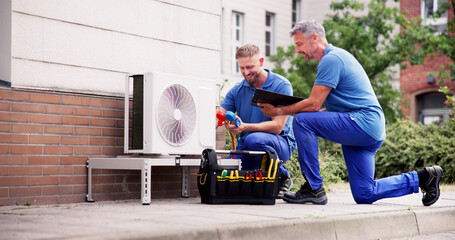Before starting the actual AC installation, technicians conduct a pre-installation inspection and assessment. This will help determine the best system for your home’s unique cooling needs. Reach out to Air Conditioning Installation Provo UT for expert assistance.

Technicians use a recovery machine to drain any refrigerant from the existing air conditioner into a tank. Next, they disconnect the electrical wiring from the old unit and install a disconnect box.
Air conditioning installation is a meticulous process that requires the expertise of certified technicians to ensure optimal performance and efficiency. It is not a job to be undertaken by DIYers or by companies that prioritize speed over accuracy and safety. Understanding the process can help homeowners make smarter choices about where to have their units installed, how they should be mounted, and what services are needed to ensure proper operation for years to come.
Prior to starting the actual AC installation, a technician will verify that the home is ready for the new equipment. This might involve clearing space for the indoor and outdoor unit, checking electrical connections, or ensuring proper insulation. It is vital that this step is not skipped, as mistakes can be costly to the homeowner and result in a subpar cooling system.
Once the area is cleared, the technicians will begin to mount the indoor and outdoor units. They will follow manufacturer guidelines to ensure the unit’s warranty remains valid and that the installation adheres to local building codes. The location of the indoor and outdoor units is critical, as the correct size of an AC unit can have a big impact on efficiency and comfort.
The technicians will also install a service disconnect box on the side of the house and wire it to the existing panel. Then, they will check that the breaker is rated for overcurrent protection. Finally, the high- and low-voltage wiring will be connected to the new breaker.
Once all of the electrical connections are made, the technician will set the window unit in its opening and secure the accordion-style side panels. For wall units, the mounting brackets will be attached to the studs. For ductless systems, the installer will bolt the compressor condenser to the ground or a provided equipment stand.
For ducted systems, the evaporator coils and furnace will be connected with sheet metal screws. Then the duct runs will be sealed and insulated with duct mastic to prevent condensation and energy loss. After the ducts are properly sealed, the compressor condenser will be connected to the evaporator coils with refrigerant lines.
Checking the Ductwork
Your home’s ductwork is the means by which conditioned air travels from your furnace and/or AC unit to the rooms in your house. Leaky ducts waste energy and reduce indoor comfort by allowing unconditioned air to circulate. This can result in hot or cold spots throughout your home, as well as higher utility bills. If you notice unexplained increases in your home energy costs, a noisy duct system, or excessive dust around your registers, it’s time to have the ductwork evaluated.
Fortunately, inspecting your ductwork doesn’t have to be an expensive or complicated task. A professional from Bud Matthews Services can perform a visual inspection to check for loose or disconnected sections, holes, or leaks. They’ll also evaluate the ductwork’s insulation and recommend improvements if necessary.
The most common sign that a duct system needs repair is a noticeable difference in temperature between rooms in your home. If a particular room is always hotter or colder than others, it’s likely that the ductwork to that room is either blocked or inadequately sized. In addition to distributing conditioned air unevenly, this can cause your system to work harder than it should to maintain your desired temperature settings.
Another way to detect duct leaks is by opening your registers and observing whether or not conditioned air flows out of them. You can also feel the airflow by touching each vent to see if it’s cool, which indicates proper flow. The sound of whistling or whooshing noises as the HVAC system operates is an indication that there are gaps in the ductwork.
Leaky ducts aren’t just inefficient, they can be dangerous to your family’s health. Gaps in ductwork allow pollutants to circulate into your home, including allergens like pollen and dust mites. These contaminants can aggravate asthma and allergies, as well as lead to mold growth and unpleasant smells. The good news is that most ducts are located in the attic, where they’re easy to access. In some cases, a homeowner with a DIY spirit can even do the inspection and repairs themselves to save money on their energy bills.
Installing a Thermostat
Thermostat installation is one of the most common parts of an air conditioning installation. Whether you’re replacing an existing thermostat or adding a smart thermostat, the process is relatively simple. It involves loosening a few screws, connecting the wires to their corresponding terminals, and mounting the back plate.
Start by making sure that you have the correct model. Your new thermostat should come with a wall plate or base, a back plate (which you’ll screw to the wall), and a set of screws, wall anchors and labels for the system wires. It should also have a power accessory (in case your system doesn’t have a C-wire to provide consistent power) and a trim kit, which covers the screw holes when you’re done.
Next, you’ll remove the old thermostat base by unscrewing it. Be careful not to pull out the low-voltage wiring that’s connected to it. Some smart thermostats include stickers that label the wires, which can be helpful if you didn’t use stickers when you removed your old thermostat. It’s a good idea to take a photo of the wiring before you begin, so you can reference it later.
If you have a multistage heating and cooling system, you’ll want to make sure that your new thermostat is compatible with it. This usually involves confirming that it’s compatible with your furnace and condenser, but it may require an electrical test as well. Contact your HVAC technician if you’re not comfortable doing this yourself or if the manufacturer’s documentation is unclear.
Once you’ve reconnected the wires to their corresponding terminals, it’s time to connect the new thermostat. It should have a lever that you can press down to insert a wire, and it should stay depressed when the wire is properly connected. You should also insert any labeled jumper wires between the terminals, like Y to Y1.
The last step is to mount your new thermostat to its wall and plug it in. If your new thermostat is a smart thermostat, you’ll need to link it to your Wi-Fi and then follow its manufacturer instructions to program your schedule and preferences.
Commissioning
The commissioning of air conditioning systems is an important step in the process. It ensures that the equipment is properly installed and ready for operation. It also helps to identify any potential problems that may need to be addressed in the future. Without this service, there is a risk of having to deal with costly repair bills or lost productivity.
During this process, the technician will use a recovery machine to drain any refrigerant that is in the system. This is done because it is against the law to vent refrigerant into the air. Then, he will check the charge level and verify that it is in accordance with factory specifications. After that, he will run the unit and test the performance to make sure it is cooling as intended. He will also compile a comprehensive air conditioning commissioning report, which the client should receive.
Some contractors choose to skip this step because it is a bit more expensive than the installation itself. However, it is much cheaper in the long run to perform this service. It will help to keep the equipment running at peak efficiency, which will save money on energy costs and reduce repair expenses. Plus, it will help to ensure that the air quality in the building is up to standards.
The best way to protect yourself from an air conditioning installation that will go wrong is to hire a professional company with a proven track record. Make sure that they follow this comprehensive process and do not skip any steps. This will ensure that your new system will operate correctly and efficiently for years to come. This will give you peace of mind, and it will also allow your employees to work comfortably and productively. After all, who wants to be stuck in a hot office while they are trying to complete their jobs? A well-trained installation team will ensure that your air conditioning system is commissioned before they leave the job. This will help you to avoid future issues and to get the most out of your investment in new HVAC equipment.

